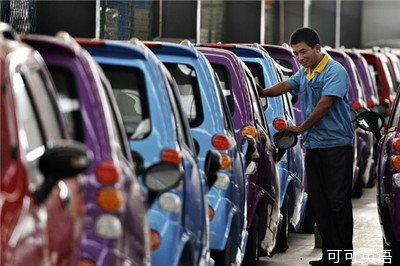
A key gauge of China's factory activity lost ground in February, extending a January drop and falling to a seven-month low, signaling further weakness in the world's No. 2 economy.
一項衡量中國制造業(yè)活動的關(guān)鍵指標在2月份出現(xiàn)下滑,延續(xù)了1月份的下降勢頭并創(chuàng)下七個月新低,這預示中國這一全球第二大經(jīng)濟體將進一步走軟。
The data unnerved Asian markets shortly after its release on Thursday, though analysts cautioned that seasonal factors such as the timing of the Lunar New Year holiday probably played a role in the result.
周四該數(shù)據(jù)公布后不久,亞洲市場一度躁動不安,但分析人士提醒道,春節(jié)假日的時間等季節(jié)性因素很可能對制造業(yè)數(shù)據(jù)產(chǎn)生了影響。
The preliminary HSBC China Manufacturing Purchasing Managers' Index, a gauge of nationwide manufacturing activity, fell to 48.3 in February from 49.5 in January, HSBC Holdings PLC said Thursday.
匯豐控股有限公司(HSBC Holdings PLC, 簡稱:匯豐控股)周四公布,2月份匯豐中國制造業(yè)采購經(jīng)理人指數(shù)(PMI)初值為48.3,低于1月份的49.5。
A reading above 50 indicates expansion from the previous month, while a reading below 50 indicates contraction.
該指數(shù)高于50表明制造業(yè)活動較前月擴張,低于50則表明制造業(yè)活動萎縮。
The reading follows similarly glum results from January. Both the official and the HSBC manufacturing PMI readings lost ground then, with the HSBC index showing contraction.
2月份制造業(yè)數(shù)據(jù)延續(xù)了1月份的黯淡表現(xiàn)。1月份中國官方制造業(yè)PMI和匯豐制造業(yè)PMI均有所下滑,其中匯豐PMI還顯示制造業(yè)萎縮。
Economists said the result likely indicates a slowdown in the final part of last year is continuing into this year, reinforcing the view that this year's growth in gross domestic product will likely trail last year's 7.7%. China's economic growth slowed in the final quarter of last year, also to 7.7%, from 7.8% in the third quarter, amid a combination of weak domestic demand and a still- recovering global economy.
經(jīng)濟學家們說,最新制造業(yè)數(shù)據(jù)可能表明去年年末制造業(yè)的下滑勢頭延續(xù)至今年,這強化了人們對于今年國內(nèi)生產(chǎn)總值(GDP)增幅可能低于去年的7.7%的看法。去年第四季度中國經(jīng)濟增速也有所回落,從第三季度的7.8%降至7.7%,主要受國內(nèi)需求疲軟以及全球經(jīng)濟仍在復蘇當中的共同影響。
'There is continued downward pressure on the economy,' said Ding Shuang, an economist at Citigroup. 'Economic growth will continue to decline to 7% over the next two quarters.'
花旗集團(Citigroup)經(jīng)濟學家丁爽說,中國經(jīng)濟持續(xù)面臨下行壓力,未來兩個季度經(jīng)濟增速將進一步回落至7%。
'We reiterate our view that the recovery in China is not sustainable and that GDP growth will slow to 7.5% year-over-year in the first quarter and 7.1% in the second quarter, despite favorable base effects,' said Zhiwei Zhang, an economist at Nomura.
野村(Nomura)經(jīng)濟學家張智威說:“我們?nèi)哉J為中國的經(jīng)濟復蘇不可持續(xù),今年第一和第二季度GDP同比增幅將分別回落至7.5%和7.1%,盡管基數(shù)效應有利。”
The weakness in China's economy hit markets. The Australian dollar weakened to $0.8957 from $0.9004 shortly after the data announcement. Australia is a major supplier of resources to fuel China's economic growth. Hong Kong's benchmark stock index was down 1.6%.
中國經(jīng)濟的低迷表現(xiàn)對市場構(gòu)成沖擊。上述制造業(yè)數(shù)據(jù)公布后不久,澳元一度從0.9004美元跌至0.8957美元。澳大利亞是中國經(jīng)濟增長所需資源的主要供應國。香港股指跌1.6%。
All of the subindexes of the PMI showed weakness, with new orders, new export orders and employment declining, according to HSBC.
匯豐稱,所有PMI分類指數(shù)均顯示中國制造業(yè)疲軟,其中新訂單、新出口訂單和就業(yè)分類指數(shù)均有下滑。
The preliminary PMI figure, also called the HSBC Flash China PMI, is based on 85% to 90% of total responses to HSBC's PMI survey each month, and is issued about one week before the final PMI reading.
匯豐制造業(yè)PMI預覽指數(shù)是根據(jù)每月采購經(jīng)理人問卷反饋總樣本量的85%-90%為依據(jù)編制的,于PMI終值發(fā)布前一周左右公布。


